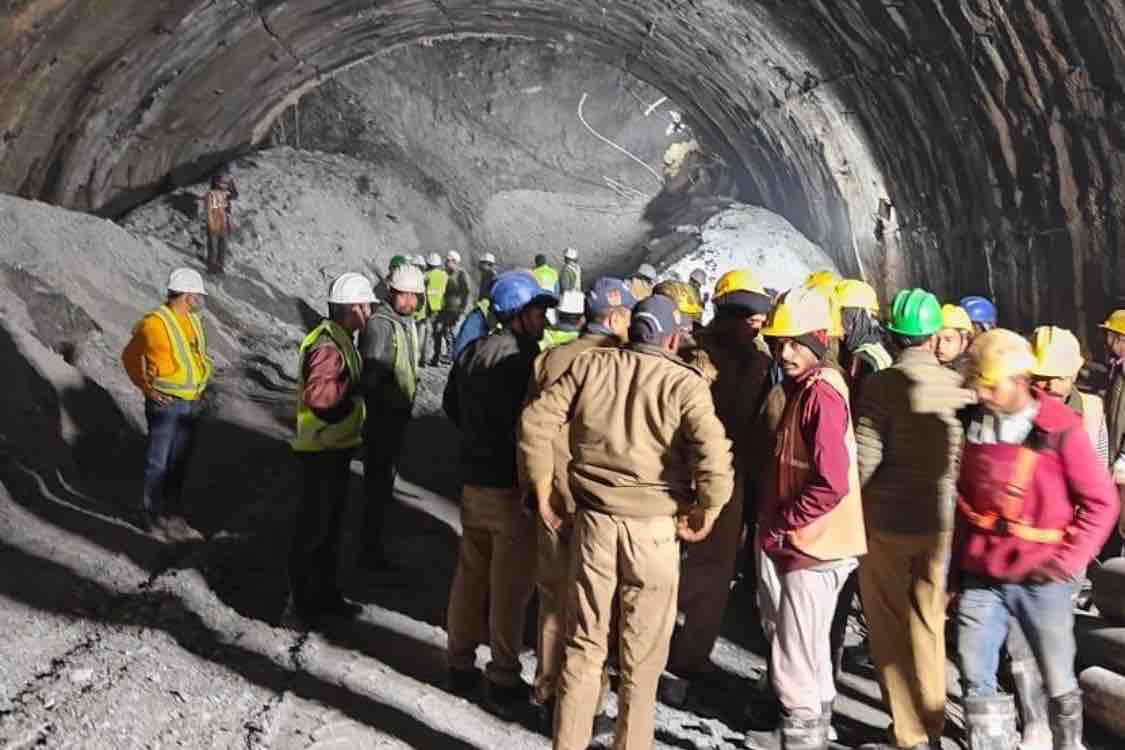Lessons from the Silkyara Tunnel Collapse: Stop Destruction in the Name of Development

Forty-one construction workers who remained trapped in a partially collapsed tunnel in Uttarakhand since 12 November, 2023, were finally rescued on the seventeenth day. After machines broke down it was ‘rathole miners’ (skilled manual earth diggers) who ultimately came to the rescue at great risk to their own lives. In recent times we have seen organised state-sanctioned violence to expel Muslims from Uttarakhand, yet Muslim rathole miners came to Uttarakhand to join this rescue mission. The media and the state and central governments initially paid little attention to the mishap. It was only after the world cup cricket euphoria anticlimactically ended in India's shock defeat to Australia in the November 19 final that the Silkyara tunnel collapse started receiving some attention in the media. The least that must be demanded from the rulers is restraint in 'exhibiting their care and concern' for the rescued workers. Only the other day we saw how insensitive UP ministers sought to hand over cheques in front of camera to the inconsolable mother of Captain Shubham of Agra who had been killed in Rajouri, prompting her to say 'pradarshani mat lagao' (don't make a spectacle).

The rescue operation had been a thoroughly casual affair from the very beginning. The Hyderabad-based Navyug Engineering Company (reportedly now being owned by the Adani group), which has the tunnel construction contract, had no wherewithals to deal with an emergency like the Silkyara tunnel collapse. It should be noted that the same company was responsible for the death of twenty labourers in August this year in an accident in Nagpur-Mumbai Samruddhi expressway and a case of culpable homicide has been registered against the company. Yet there has been no monitoring of the company's work in Uttarakhand. An auger machine was brought from Delhi to conduct the drilling and when it ran into trouble a second machine was brought from Indore. When the second machine too developed problems, experts were summoned from Delhi. Yet on the 13th day, all attempts had to be given up on getting the machine running. On the 15th day of the tunnel collapse the National Disaster Management Authority eventually deployed army engineers and rathole miners who finally succeeded in rescuing the workers.
When the Silkyara Bend - Barkot tunnel project was approved by the Cabinet Committee on Economic Affairs in February 2018, it included a mandatory provision for an escape passage. Whatever happened to that provision? Norms have clearly been violated at every stage of construction. No wonder Uttarakhand has been witnessing such construction related accidents increasingly frequently. Five years ago, on 21 December 2018, seven workers had perished in a landslide on the Rudraprayag-Gaurikund stretch of an under-construction road. In July 2020, three sleeping siblings in Khoda village of Narendranagar block of Tehri were crushed to death when the retaining wall of a highway collapsed on their house. On 20 July 2022, two labourers lost their lives and six others sustained critical injuries when an under-construction bridge collapsed in Rudraprayag district.
Such periodic accidents have now become routine features of 'development' in Uttarakhand. Two disastrous campaigns have particularly harmed Uttarakhand since the state was carved out of Uttar Pradesh in November 2000. The idea of turning Uttarakhand into 'Urja Pradesh' or India's energy hub by building a string of hydel power plants and the fad of linking the four key pilgrimage centres - Badrinath, Kedarnath, Gangotri and Yamunotri - with faster all-weather road and rail connectivity have unleashed havoc in this Himalayan state. Known as the Char Dham (four pilgrimage centres) project, this faster road connectivity project has been designed to destroy the delicate and ecologically sensitive and earthquake-prone Himalayan ecosystem. To avoid environmental compliance for projects exceeding 100 km, the close to 900 km Char Dham project has been presented as a cluster of 53 separate projects. Allied with the road connectivity project, there is also a 372 km long Char Dham Railway Project with an estimated cost of 72,000 crore rupees and involving the construction of dozens of tunnels. From massive destruction of Himalayan forests to reckless tampering with the fragile mountain system, the Char Dham Road and Rail projects are a complete design of disaster. From Joshimath to Silkyara, the writing on the wall can be read in big bold letters.
Enough warnings have also been issued by experts and courts. Eminent environmentalist Ravi Chopra who headed the Supreme Court appointed expert panel that examined the Char Dham project resigned to register his protest against total inaction of the government. To secure the approval of the Supreme Court, the government had invoked the angle of national security and improved mobility of the defence forces in support of the Char Dham project. The Supreme Court endorsed the project only on condition of mandatory compliance with necessary environmental safeguards. But so far there has been no sign of compliance or course correction. In the name of development, the Himalayan ecosystem continues to be subjected to relentless corporate invasion and plunder. Coupled with the growing intensity of climate crisis, this paradigm of development can only be a recipe for unmitigated serial disaster. The success in saving the lives of the forty-one trapped workers in the Silkyara tunnel must not lead to complacence and resumption of business as usual. The Silkyara tunnel collapse only highlights the urgency of saving Uttarakhand and the Himalayan ecosystem from the ongoing campaign of destruction.
Charu Bhawan, U-90, Shakarpur, Delhi 110092
Phone: +91-11-42785864 | +91 9717274961 E-mail: info@cpiml.org

